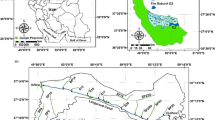Abstract
The Mae Lao Irrigation Scheme is one of the largest irrigation projects in Northern Thailand. According to the field reconnaissance, water shortage usually occurs during the dry season. And it is very difficult to equally distribute available water to the paddy fields from the upstream to the downstream parts of the system. To understand and identify the causes of the problems, the measurement of water level and flow rate along all canals may be effective. However, it is not easy to achieve this in such a large-scale irrigation system. Thus, the numerical simulation becomes the second option. The objective of this study is to identify and quantify the real water shortage causes by developing an Unsteady Irrigation Water Distribution and Consumption model which can simulate the water movement and consumption in the whole irrigation system. The beneficial area of the right main canal is modeled based on the physical aspect of the system. The components of the model consist of canal networks, control structures, and paddy fields. A canal is divided into several portions called reach. The Saint-Venant equations are applied to describe the unsteady water movement in each reach. Flow movement at the control structure is expressed by the boundary condition. The paddy fields are modeled to make paddy block and connected to each reach. The water consumption in each paddy block is estimated by Paddy Tank model. The numerical model is successfully developed showing the ability to simulate the water movement and consumption properties in this irrigation system.














Similar content being viewed by others
References
Abbott MB (1979) Computational hydraulics: element of the theory of free surface flows. Pitman, London, pp 1–55
Chinh LV, Hiramatsu K, Harada M, Mori M (2006) Optimal gate operation of a main drainage canal in a flat low-lying agricultural area using a tank model incorporated with a genetic algorithm. J Fac Agric Kyushu Univ 51(2):351–359
Chow VT (1959) Open-channel hydraulic. Mcgraw-Hill, New York, pp 525–580
Clemmens AJ, Holly FM, Schuurmans W (1993) Description and evaluation of program: Duflow. J Irrig Drain Eng 119(4):724–734
Cunge JA, Holly FM Jr, Verwey A (1980) Practical aspects of computational river hydraulics. Pitman Publishing, London, pp 7–19
DHI Water and Environment (2002) Mike11, A modeling system for rivers and channels, User Guide, Denmark
Gentle JE (2005) Statistics and computing random number generation and Monte Carlo methods, 2nd edn. Springer, New York, pp 171–174
Jeffrey A (2002) Advanced engineering mathematics. Harcourt/Academic Press, USA, pp 1044–1058
Kohno E (1992) Paddy fields with all Asian types of water use in Thailand. In: Tabuchi T, Hasegawa S (eds) Paddy Fields in the World, 1st edn. The Japanese Society of Irrigation, Drainage and Reclamation Engineering, Tokyo, pp 181–198
Kubo N, Don NC (2000) Integration of tank and unsteady flow models. Rural Environ Eng 39:25–35
Lax PD, Wendroff B (1960) Systems of conservation laws. Commun Pur Appl Math 13:217–237
Merkley GP, Rogers DC (1993) Description and evaluation of program Canal. J Irrig Drain Eng 119(4):714–723
RID Royal Irrigation Department (1999) Report of the Feasibility Study and Design Detail for Improving 5 Irrigation Projects, Bangkok, Thailand
RID Royal Irrigation Department (2003) Final Report of the Constructing Concrete Dam, Mae Suai Project, Chiang Rai Province, Bangkok, Thailand
Rogers DC, Merkley GP (1993) Description and evaluation of the program USM. J Irrig Drain Eng 119(4):693–702
Schuurmans W (1993) Description and evaluation of program Modis. J Irrig Drain Eng 119(4):735–742
Somura H, Tanji H, Yoshida K, Toda O (2004) Model Development for Estimating Irrigated Water in Kandal Province, Cambodia. In: Proceedings of ICID 2nd Asian Regional conference (Australia), Session 4, Stream 1, 1–10 (CD)
Wongtragoon U, Kubo N (2006) Identification of Irrigation Management Problems in Dry Season of Mae Lao Operation and Maintenance Irrigation Project. In: Proceedings of international conference on Mekong research for people of the Mekong, Thailand, pp 499–504
Zimbelman DD, Bedworth D (1983) Computer control for irrigation-canal system. J Irrig Drain Eng 109(1):43–59
Acknowledgments
The research described in this paper is supported by funds of the Core Research for Evolutional Science and Technology, Japan Science and Technology CREST-JST. We sincerely thank the staff of the Mae Lao Operation and Maintenance Project, Chiang Rai, Thailand, for their assistance during the field reconnaissance and data collection. The author gratefully acknowledges the useful comments of all members of the Water System Engineering Laboratory’s Tokyo University of Agriculture and Technology. Especially, the previous studies were done by Ms. Yuki Okubo and Mr. Shuji Uratani.
Author information
Authors and Affiliations
Corresponding author
Rights and permissions
About this article
Cite this article
Wongtragoon, U., Kubo, N. & Tanji, H. Performance diagnosis of Mae Lao Irrigation Scheme in Thailand (I) Development of Unsteady Irrigation Water Distribution and Consumption model. Paddy Water Environ 8, 1–13 (2010). https://doi.org/10.1007/s10333-009-0169-7
Received:
Revised:
Accepted:
Published:
Issue Date:
DOI: https://doi.org/10.1007/s10333-009-0169-7




